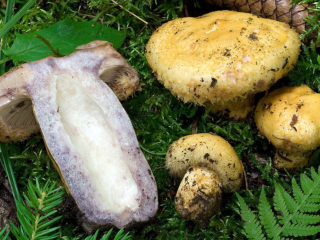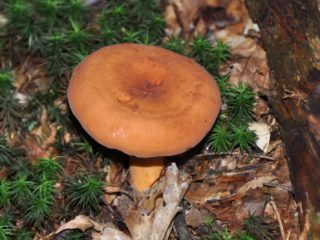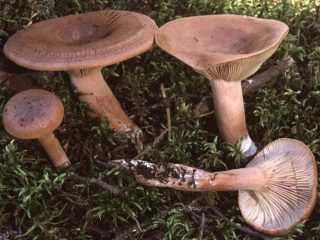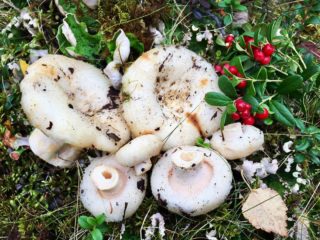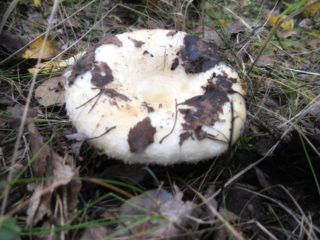Content
If milk mushrooms have darkened, this is usually not a reason to panic - the process is completely natural. But at the same time, it is interesting to know for what reasons mushrooms darken, and what can be done in such a situation.
Why do milk mushrooms darken?
White milk mushrooms delight lovers of mushroom pulp not only with their taste, but also with their pleasant light color. However, during processing, an unexpected problem often arises - the white milk mushrooms turn black or change color to dark blue and dark brown. You can encounter the fact that the product has darkened at any stage of preparation - during soaking, boiling, and even during the salting process.
Seeing that the milk mushrooms have darkened, inexperienced mushroom pickers often get scared and think that they have collected false, inedible doubles. But in fact, darkening is a natural process and does not contain any danger.
The fresh pulp contains milky juice, which gives raw mushrooms an unpleasant bitter taste.When the pulp is cut or broken, this juice enters into a chemical reaction with air and first acquires a yellow-gray color, and then completely turns black. If the mushroom caps turn black, this means that milk remains in their pulp, which has changed its color due to interaction with oxygen and other environmental factors.

Mushroom caps turn black from exposure to air
Why do milk mushrooms darken when soaked?
White milk mushrooms belong to the highest food category, in other words, they are one of the safest, tastiest and healthiest mushrooms. However, it is not recommended to eat them raw - first, the collected fruiting bodies must be soaked in water. Moreover, soaking takes a fairly large amount of time - from 1 to 3 days.
It is necessary to soak the mushroom pulp not only to remove possible toxins, but also to prevent it from turning black. Long-term soaking allows you to remove the milky juice and preserve the pleasant white color of the pulp, as well as eliminate the bitter aftertaste.
During the soaking process, the water must be regularly replaced with fresh water. Otherwise, the pulp will continue to come into contact with its own milky juice and, accordingly, will most likely turn black and remain bitter.
If soaked milk mushrooms darken directly in the water, there may be several reasons:
- The specimens collected in the forest had been exposed to air without water for too long and had already begun to change their color.
- When soaking, the water was not changed for a long time, so both the mushrooms and the liquid itself darkened.
- There was not enough water in the container with the mushroom caps, and they partially came into contact with the air.
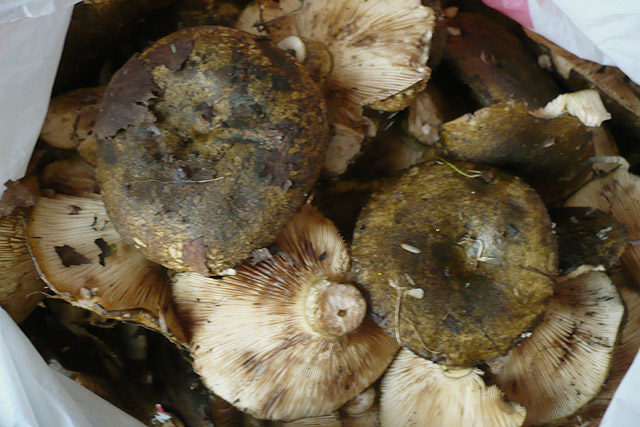
To prevent mushroom caps from turning black, they need to be soaked immediately.
The problem may also appear if a container with soaked mushroom caps was placed in the light, and exposure to ultraviolet rays caused them to darken even under water.
Why do milk mushrooms darken when cooked?
Sometimes you may encounter the fact that light-colored caps darken not during the soaking process, but during boiling. Most often there is only one reason - there is not enough water in the pan to cover the entire fruiting body.
The milky juice, which causes the unpleasant situation with color change, permeates all the pulp. Accordingly, even with long soaking it does not disappear completely and remains in the pulp in small quantities. If the fruiting bodies were boiled in a small saucepan and partially protruded above the water, then contact with air could result in the remaining milky juice turning the pulp dark.
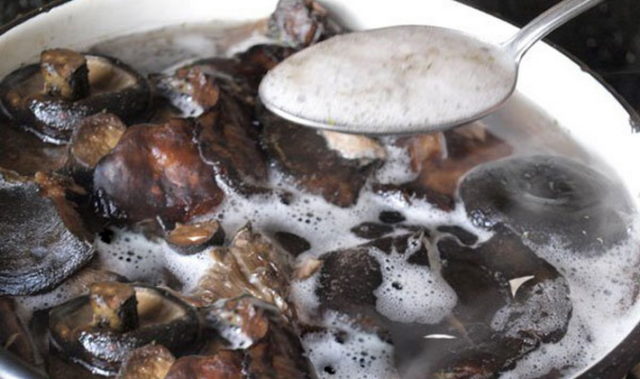
It is recommended to add more water when boiling.
Why do milk mushrooms darken when salted?
Another popular cooking option for long-term storage is pickling. Sometimes the fruiting bodies are pre-boiled, sometimes they are just soaked and immediately placed in a jar, generously sprinkled with salt and spices.
In both cases, you may encounter the fact that the salted milk mushrooms turn blue in the jar just a few hours after salting. There are 2 reasons why milk mushrooms in jars darken:
- The fruiting bodies were old and overripe.There is more milky juice and bitterness in mature caps, so during processing you may often find that they darken and remain not very pleasant to the taste.
- Not enough salt was poured into the jar, and as a result, the brine was not enough; it was not able to completely cover the mushroom pulp. In this case, it can be argued that the product has darkened due to contact with air.
If the fruiting bodies have darkened after salting, it is recommended to remove them from the jar and carry out the procedure again, with fresh mushrooms or a large amount of brine.
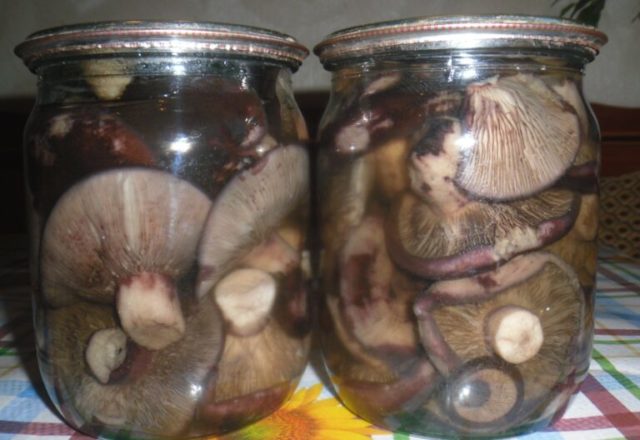
During the salting process, it is better not to skimp on salt.
Why did the brine darken when salting milk mushrooms?
Sometimes it happens that when fresh mushrooms are cold processed, it is not the milk mushrooms in the jar that darken, but the brine itself in which they lie. The reasons remain the same - a change in color means that the fruiting bodies were overripe, or not enough salt was put in the jar to create the required amount of brine.
If the brine has darkened, then in any case this indicates a violation of the mushroom pickling technology. It is better to pour the salted liquid from the jar, thoroughly rinse the mushroom caps and salt them again, following all the rules, carefully monitoring the volume of brine.
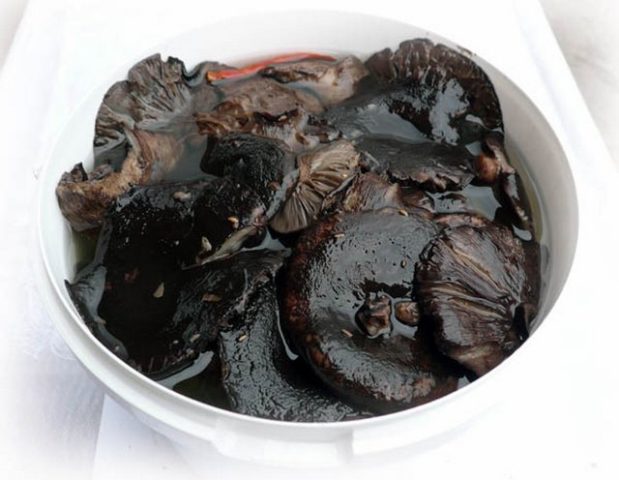
Browned mushroom caps are still edible, but may be less tasty.
Is it possible to eat milk mushrooms if they have darkened?
A very pressing question is whether darkened mushroom pulp can be eaten or whether it is better to throw it away. The answer depends on the situation - in most cases the mushrooms remain edible, but sometimes they really need to be replaced:
- It sometimes happens that the fruiting bodies darken even before processing, right in the basket on the way home or on the table, before they were immersed in water for soaking.In the first case, this indicates overripeness, in the second, that they were left in the air for a long time. Such milk mushrooms can be thrown away, even if they have not had time to really deteriorate; it will be difficult to remove the bitterness from them and return the pulp to a light color.
- If the fruiting bodies have already darkened in cold water, during boiling or during the pickling process, then it is not necessary to dispose of them. Usually the mushrooms can still be returned to their white color and good taste.
In general, if milk mushrooms turn blue after salting, boiling or soaking, this does not mean they are unsuitable for food. Blackened caps may turn out to be less beautiful and not as pleasant to taste, which is why it is recommended to take measures to return them to a light shade.
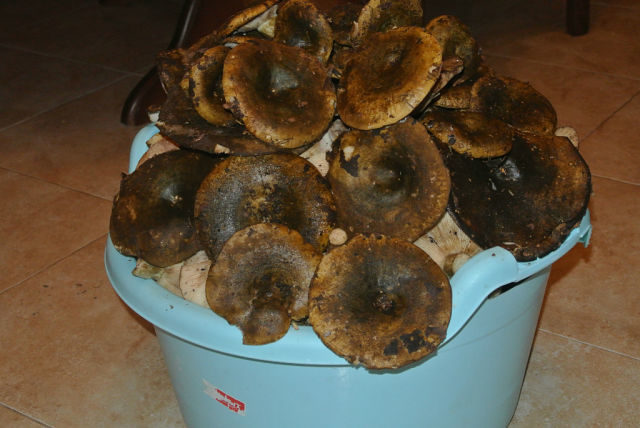
Darkened milk mushrooms can be bleached
What to do to prevent milk mushrooms from darkening
If the mushroom bodies have darkened, you can bleach them, but this will require some effort. It is easier to prevent color change and try to ensure that the mushrooms do not darken at all.
You can maintain the light shade of white milk mushrooms if you follow several recommendations:
- You need to collect young and fresh specimens in the forest; the younger the milk mushroom, the less bitter milky juice in its pulp.
- Immediately upon arriving home, the milk mushrooms must be immersed in water to soak so that they do not darken; the water should cover them entirely. Fruiting bodies should not be left exposed to air for a long time, otherwise discoloration will become almost inevitable.
- During the soaking process, the water must be regularly drained and replaced with fresh water every few hours, otherwise the meaning of the treatment will be lost, and a situation will arise where the milk mushrooms not only darken, but also remain bitter.
- When boiling, the mushroom bodies must also be filled with water entirely so that the liquid covers the milk mushrooms by about 1 cm from above. Then during the cooking process they will not come into contact with oxygen, and you will not have to deal with the fact that the mushrooms have darkened.
- When salting, it is necessary to follow classical processing technologies and sprinkle each layer of mushroom pulp with a sufficient amount of salt. A couple of days after preservation, the brine should cover the fruiting bodies entirely; there should be no “pockets” of air left in the jar.
In order to better remove the milky juice from the pulp of mushrooms, before salting they must be soaked according to the standard algorithm. It is also recommended to boil the mushrooms; in this case, when preserved, they will contain a minimum of milky juice.
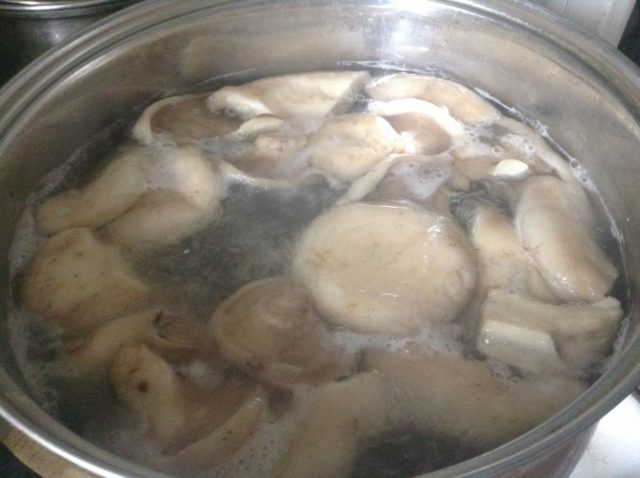
When soaking caps, the water must be changed more often
How to bleach milk mushrooms
If an unpleasant situation does arise and the fruiting bodies have darkened, you can try to bleach the mushrooms. They do this as follows:
- fruiting bodies that have darkened are placed in a pan and completely filled with water - the liquid should cover the mushrooms entirely;
- add a few large spoons of salt and a little citric acid to the water - the water should become slightly sour;
- darkened mushrooms are boiled in sour-salted liquid for 15 minutes.
After this, the solution is drained, and the mushrooms are again filled with clean water and cooked for another quarter of an hour without adding citric acid and salt. Usually, already at the first stage of processing, the mushrooms return to their original light color.
If the pickled milk mushrooms have darkened, the brine should be drained from the jar and the fruiting bodies should be immersed in cold water for several hours. After this, they are boiled according to the algorithm given above, and then salted again, carefully controlling the amount of salt.
Useful tips
There are secrets to ensure that milk mushrooms do not darken even before processing begins. First of all, it is recommended to immediately put them in cold water upon arrival from the forest. It is best to clean and cut fruit bodies directly in water.
If the fruiting bodies in a container with water constantly float to the surface, they can be pressed down with a weight so that they do not darken. Mushroom caps protruding above the water, one way or another, come into contact with air.
Since the color of the mushroom pulp is affected not only by the air, but also by the light of the sun, the fruiting bodies should be soaked in a shaded place. You should not leave the bowl on a lit windowsill.
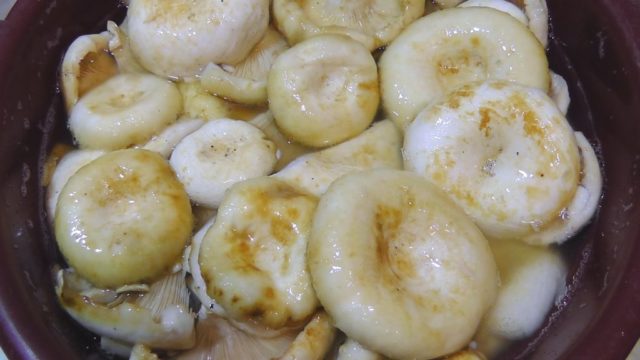
Citric acid will help return mushrooms to their white color.
Conclusion
If the milk mushrooms have darkened, they can be bleached using simple methods - a change in color most often does not indicate that the mushroom bodies have deteriorated. But it’s easier to process the mushroom pulp correctly from the very beginning, in which case it will not change color.


